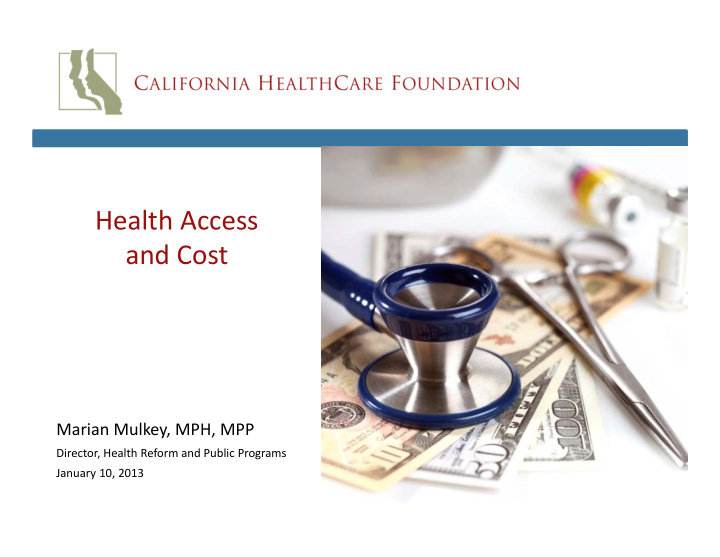



Health Access and Cost Marian Mulkey, MPH, MPP Director, Health Reform and Public Programs January 10, 2013
Agenda � Health care spending and cost drivers � Coverage sources and programs � Medi ‐ Cal � The Affordable Care Act 2
Health Spending as a Share of GDP United States, 1960 to 2020, selected years 3
Health Spending Per Capita and as a Share of GDP 4
Per Capita Health Spending, by State of Residence, 2009 5
Cost Drivers � Increased incidence of disease • Aging and other demographic factors • Obesity and other risk factors � Rising prevalence of treated disease • New technology, drugs and treatments • Earlier, more expansive diagnoses • Hospitalization and high costs approaching end of life � High price of health care services • Provider payments • Administrative cost • Waste 6
Observations and Discussion: Health Spending � Spending on health care represents almost 20 percent of our national economy � Public sector budgets, private businesses and individuals all bear a large share of the cost � Many factors contribute to rising health care spending; a range of approaches is needed to address high spending 7
7 million 4 million 17 million 7 million Source: Legislative Analyst’s Office CalFacts 2013 8
Private and Public Coverage Trends California vs. US Residents, 1987 to 2011 9
Medi ‐ Cal vs. Medicare In California, about: 7 million enrolled in Medi ‐ Cal only 4 million enrolled in Medicare only 1 million “Duals” are eligible for both Medi ‐ Cal and Medicare 10
Observations and Discussion: Coverage � About half of Californians get coverage via employers, but that share is declining � 7 million Californians depend on Medi ‐ Cal alone for coverage � 1 million Californians are enrolled in both Medicare and Medi ‐ Cal � About one in five Californians is uninsured 11
State Budget Distribution, FY 2008 ‐ 2009 12
Medi ‐ Cal Funding Sources, FY 2008 ‐ 2009 13
Medi ‐ Cal Beneficiary Profile 14
Medi ‐ Cal Beneficiaries and Cost 15
Health Care Cost Trends 16
Medi ‐ Cal Spending Levers � Number of people enrolled � Level of benefits � How much providers are reimbursed � How care is delivered 17
Managed Care and Fee ‐ for ‐ Service � In Fee ‐ for ‐ Service arrangements: • Enrollees may see any provider that accepts Medi ‐ Cal • Providers are paid for each service provided � Under managed care: • Enrollees obtain care through a designated network of providers • Health plans are reimbursed on a capitated basis to provide a defined set of Medi ‐ Cal covered services 18
Source: Legislative Analyst’s Office CalFacts 2013 19
Overall Perceptions of Medi ‐ Cal 20
Access to Appointments with Providers, Medi ‐ Cal vs. Other Coverage 21
Observations and Discussion: Medi ‐ Cal � California and federal government share costs and accountability � Medi ‐ Cal provides care to 8 million low ‐ income Californians � It accounts for about one ‐ fifth of state general fund spending � One ‐ quarter of beneficiaries account for more than one ‐ half of program costs � Compared to private insurance premiums, Medi ‐ Cal per person spending has increased modestly in recent years � Enrollees appreciate the program, yet face challenges in accessing care 22
Coverage Provisions of the ACA In 2014, the Patient Protection and Affordable Care Act (ACA) will broadly expand health coverage through: � Medicaid (Medi ‐ Cal in California) expansion � Insurance market reforms � New individual responsibilities � New employer responsibilities � Establishment of state insurance exchanges 23
Additional Provisions of the ACA � Test new ways to pay for and organize care � Prevention and wellness provisions � Workforce training and development � Data transparency and accountability 24
25
Recommend
More recommend